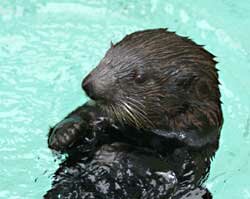 Sea Otters Sea Otters
scientific name
Enhydra lutris
size
Length: max 6 ft. long, usually 40 - 60 in.
Weight. males 60 - 70 lbs. " females 35 - 64 lbs.
Body & Head: 3 - 4 ft.
Tail: 22 -33 in.
characteristics
Color: black to dark brown except grayish or creamy head, throat and chest.
Feet: claws semi-retractable " fingers agile " hind feet webbed and flattened into broad flippers.
Body: does not have subcutaneous layer of fat but rely on air trapped in fur for warmth.
Fur: dense
Teeth: only carnivore with four incisor teeth in lower jaw.
behavior
diurnal " males territorial especially during breeding season (return year after year) " females social with no strict hierarchy " not migratory but may take "long trips" of 20 - 150 miles any time of year " spend night in kelp beds anchored by wrapping kelp around body to keep from drifting " use rock (or other hard object) to pry or break open urchins, abalone or other hard food.
reproduction/life span
Life span. wild 25-30 yrs " captivity 25-40 yrs
males mate with female in his territory (harem)
Gestation. 4 - 8.5 mos. (6.5 average) - implantation may be delayed.
Offspring: 1 pup, twins rare " Northern population come to shore for birth, Southern may give birth at sea or on shore " birth weight: 3 - 5 lbs. " pups have light "natal pelage" that is replaced by sleek dark fur at ~3mos. " pups born with open eyes and full set of milk teeth " length of pup dependency, 2 - 11 mos. (varies based on geographical location " birth interval ~1 - 2 yrs.
Sexual Maturity: 3 - 5 yrs.
diet
Wild. wide variety of invertebrates (clams, crabs, urchins snails, octopus, mussels, sea stars), may eat fish " individuals seem to have food preferences.
Zoo. clams, crabs, pollock fillets, urchins and clam strips.
habitat/range
Three subspecies (subtle differences) " Russian Sea Otter: Kuril Islands and the eastern coast of the Kamchatka Peninsula north to the Commander Islands " Alaska Sea Otter (Northern): Aleutian Islands to Prince William Sound and southward to Washington State " California Sea Otter (Southern): Central California coast (historically from northern California to Baja California).
status
US Threatened " CITES App II " California Sea Otter range is slowly expanding " Alaska Sea Otter populations are decreasing.
note
The Oregon Zoo has Southern Sea Otters " historically Oregon was probably where the Northern and Southern subspecies came together.
oregon zoo exhibit
Steller Cove
back to top
|


